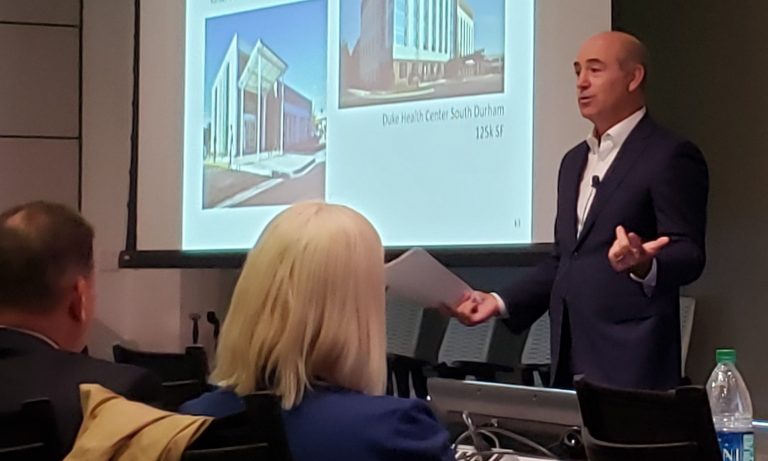‘Ambulatory hospitals,’ obsolete parking ramps, prefab construction and more
By John B. Mugford

Peter Bulgarelli, president and CEO of Lillibridge Healthcare Services, spoke to the BOMA Suburban Chicago Healthcare Real Estate Symposium audience about how to strike the right balance between current and anticipated facilities needs. (HREI™ photo)
When it comes to planning for the future of any type of business in any type of industry, there’s a fine line between looking too far ahead and not looking ahead at all.
A textbook example of a company that did not look ahead, of course, is Blockbuster, which was “making a ton of money, franchising like crazy and didn’t really think about what might happen if someone like a Netflix came into their space,” said Peter Bulgarelli, president and CEO of Lillibridge Healthcare Services, the medical office building (MOB) arm of Chicago-based Ventas Inc. (NYSE: VTR). He made his remarks during the recent 2019 Healthcare Real Estate Symposium in Rosemount that was organized by BOMA Suburban Chicago and the Association of Medical Facility Professionals.
On the other hand, “a classic example of a company focusing far too forward and not worrying about making money in order to realize your future goals – and that would be WeWork, which you’re watching collapse.”
Such potential pitfalls are certainly something health systems and all types of providers need to strategize about, as their industry is transforming as quickly as any, what with reimbursement changes on the horizon, patients demanding more convenience and transparency in the care they receive, and disruptors coming from any number of high tech companies new to healthcare.
Mr. Bulgarelli was joined on stage by Sarah Jensen, an architect and the president of Jensen + Partners, a healthcare design, planning and program management firm based in Los Angeles with offices in Chicago and Washington, D.C.
With the whole symposium and its multiple presentations focused on what lies ahead for the healthcare real estate (HRE) sector in the next decade, Mr. Bulgarelli and Ms. Jensen talked about how health systems and the healthcare facilities they operate need to be designed – or perhaps in some cases redesigned – to weather the myriad changes and disruptors facing the sector.
Their presentation was titled, “Design and Construction’s Impact on Healthcare Facilities.”
What makes it difficult for health systems to plan ahead, Mr. Bulgarelli pointed out, is that even though “value-based and risk-based reimbursements” are on the way, “it’s still (currently) a fee-for-service game and (providers) still have to play that way.”
“So, the cold hard facts of today are that health systems need to make money in declined reimbursement environments,” he said, adding that they need to do so at a time when their business model is being disrupted “in every way possible … between Google and Apple and everybody else.
“We’ve already talked today about rising outpatient acuity, so what’s the new front door?” Mr. Bulgarelli said about what health systems must do to stay relevant and be successful. “And then going further out it’s care integration, telehealth, home care, artificial intelligence, etc. So the question is, how does (a health system) really move through this in building a facility today?”
As far as the delivery of healthcare services and the designing of the buildings needed to do so is concerned, Ms. Jensen said she defines the “near” future as being the next three years and the “far” future as being everything beyond that.
“For so long, healthcare has moved so slowly,” she said, “but now we’re seeing some systems, like (Salt Lake City-based) Intermountain Health, as well as some systems in the West and the Mid-Atlantic, preparing for and already working in the ‘far.’”
The rise of the ‘ambulatory hospital’
The full content of this article is only available to paid subscribers. If you are an active subscriber, please log in. To subscribe, please click here: SUBSCRIBE





